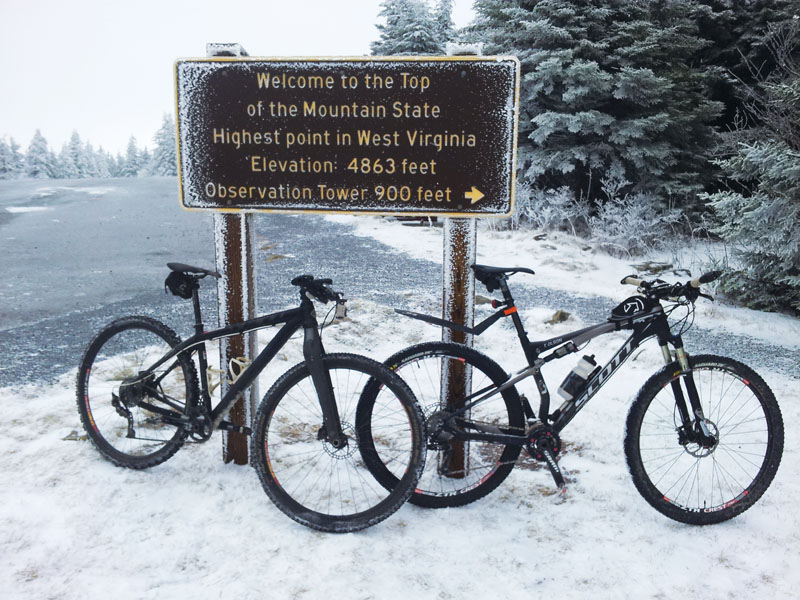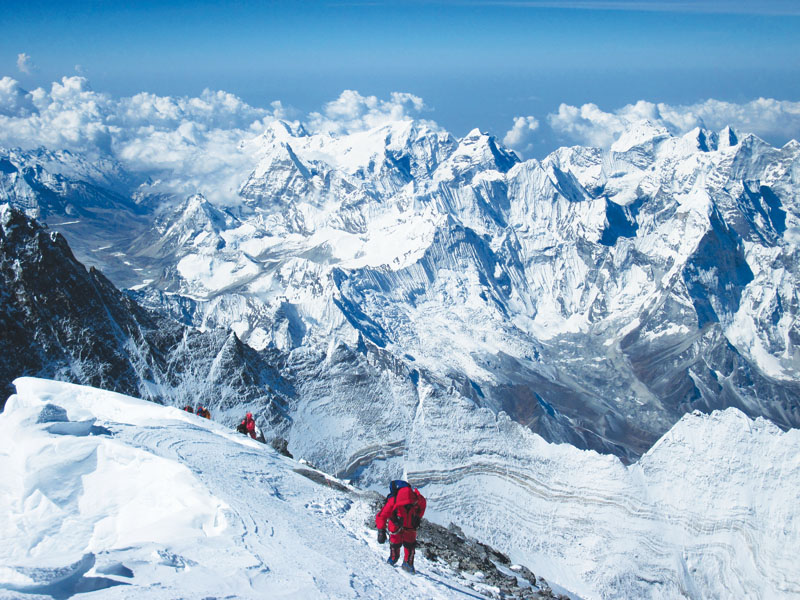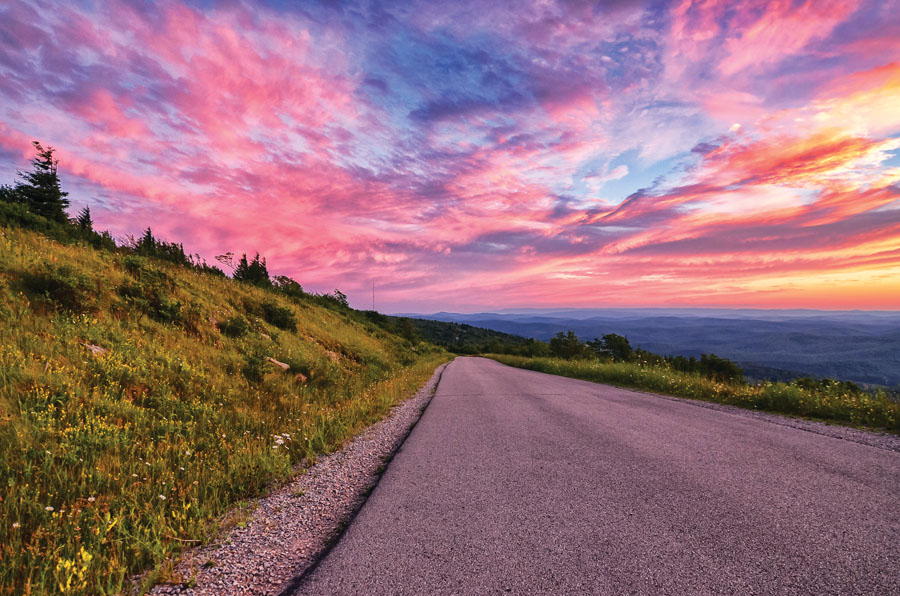When David Forkner of Franklin, N.C., started racing mountain bikes in high school, he wasn’t great. He had some natural talent, no doubt, but Forkner was fine crossing the finish line in the middle of the pack. The race was secondary to the fun.
But after attending college at Appalachian State University in Boone, N.C., during which time he raced and served as president of the collegiate cycling team for three years, Forkner decided to get serious about competing. For eight years he raced at the elite level in cat 1 road, pro mountain, and cyclocross. He won a number of regional races, including the NC State Criterium, but soon, it became apparent that his true calling wasn’t racing—it was coaching.
“The success I found through my coach led me to realize early in my career that I wanted to help others realize their potential,” writes Forkner on his Carmichael Training Systems profile.
Since 2009, Forkner has offered his training services through Carmichael and says that most of his clients aren’t professional riders, though he’s mentored a number of national and world champions. They’re time-crunched, family-oriented, working weekend warriors that want to make what little time they have to ride count.
Sound familiar? Let David help with the following bits of advice for getting back into a training routine and sticking with it.
10 Tips for Getting Back in the Saddle, and Staying There
1. Define your goals clearly.
Do you want to lose weight and get in shape? Are you prepping for a regional race? Is there a climb you’ve always wanted to tackle, but never felt fit enough to do it? Determine your goal and don’t compare it to other athlete’s goals or training regimens. “Just because you know someone who trains 20 hours a week, doesn’t mean you should or can,” adds Forkner.
2. Make training part of your schedule.
Likely the easiest excuse in the book is, “I can’t do _______ because I don’t have the time.” Get up early, stay up late, work out during your lunch break, do whatever it takes to incorporate your training as part of your routine.
3. Find what motivates you.
“I eat to ride, ride to eat,” Forkner says. “I have a system—the more you ride, the more cookies you get to eat.” So whether it’s cookies or cocktails, find a reward that gets you up and going. Joining group rides or active clubs also helps motivate, especially during the colder, darker days of winter.
4. Hold yourself accountable, or hire someone who will.
Unless you’re extremely well-versed in the ways of self-discipline, the “you don’t get a cookie if you don’t work out” tactic likely will not be enough to get you off the couch. Hiring a personal trainer, even if only for a few sessions, is an investment of your money and somebody else’s time. “It’s important to have an objective voice to tell you what to do,” says Forkner. “Even as a coach, it’s easy to talk myself out of a workout or to do something more than I should. [Having a coach] is not just for racers. It’s not just for pros. It’s for anyone who just wants to make the most of their time.”
5. Increase frequency first, then intensity.
Been off the couch for awhile? Don’t push it too hard too fast. Forkner recommends gradually building up time in the saddle to get a base level of fitness. The focus, he says, is not how hard you go but how often you do it—for the first month, maybe it’s four days a week, 90 minutes per session. “From there, I would increase frequency by 10 percent every month until that person is able to do 10—12 hours a week without problem.” Once the consistency and frequency are achieved, that’s when the intensity of the workout increases. Adding intensity too early could result in injury.
6. Cross train.
Doing the same activity day in and day out might not only get boring but potentially dangerous. “Cycling is a very one-dimensional sport,” says Forkner, so muscle groups in your core and upper body don’t really get that much attention. For peak performance, incorporate strength training and focus on parts of the body you don’t use. Not big on lifting weights? Low-impact, balance-oriented activities like swimming and yoga are great substitutes. Aim for two or three days per week of cross training for a well-rounded fitness profile.
7. Train when you’re training, rest when you’re resting.
“You don’t want to slog along in this gray zone of always kinda riding hard,” Forkner says. It will be detrimental to your body in the long run. At the very least, take one day off completely. On your other rest days, limit yourself to 60 minutes of active recovery, something that circulates the blood but keeps your heart rate low.
8. Climb hills.
And climb them frequently. “Don’t just save the big climbs for when you feel like you’re fit,” Forkner says. “You gotta train on them all of the time to get better.” After all, what doesn’t kill you only makes you stronger.

9. Embrace the foam roller.
It hurts, and it hurts for a reason, but it’s going to hurt a lot more if you wind up with an overuse injury later in the season. Prevention is key! “Ease into it,” Forkner says. “Roll out the sore muscles 10 or 15 minutes after most rides, three or four days a week. The more frequently you do it, the less overuse issues typically arise.”
10. Make mini goals.
Preparing to climb 1,000 feet every 10 miles for 100 miles straight (standard protocol in races like the Assault on Mount Mitchell) can seem, well, daunting. Start small and celebrate every step forward. Maybe it’s just a 20-mile ride with only 2,000 feet of elevation. Maybe it’s simply the fact that you didn’t have to hike-a-bike on that one climb that you normally walk. Whatever it is, use it as fuel to keep going.
[nextpage title=”Page 2″]
The 10 Best/Worst Hill Climbs
Hill climbs. It’s a love-hate thing. We love them because they make us stronger. We hate them in the moment. Whether you’re a runner, a walker, or a cyclist, these 10 hills will whip you into shape and crush your soul, but in a good way.
Windy Gap Trail, Eton, Ga.
Mileage: 4.08 miles
Elevation gain: 2,300 feet
Best part: “Knowing that once you’re done you’ve earned lots of snacks and even a few beers.”
Worst part: “Waterbars. So many steep waterbars.” —Andrew Gates, Mulberry Gap Mountainbike Getaway
Waterrock Knob, Blue Ridge Parkway, N.C.
Mileage: 5 miles
Elevation gain: 2,500 feet
Best part: Catching the sunset from the Waterrock Knob.
Worst part: Tourists.
Wayah Bald, Franklin, N.C.
Mileage: 15.5 miles
Elevation gain: 5,300 feet
Best part: Old school ridgeline trail with mountain views.
Worst part: “Miles 11-13. It’s nasty.” —David Forkner, Carmichael Training Systems
FS Road 477 to the top of Bennett Gap Trail, Canton, N.C.
Mileage: 3.6 miles
Elevation gain: 1,475 feet
Best part: “The reward! You get to descend one of the fastest, rowdiest pieces of singletrack in western North Carolina.”
Worst part: “This climb is unrelenting. It really does not let up from the time you pass the horse stables until you reach the top of Bennett. Just a nasty ol’ gravel grind.” —Cashion Smith, The Bike Farm
John Smart Trail, Chattanooga, Tenn.
Mileage: 1.5 miles
Elevation gain: 1,500 feet
Best part: “It is a great training climb. Anyone preparing for a trail race could use it as a great run-able/speed hike-able segment to prepare your legs for some vertical climb.”
Worst part: “It is relentless. Just when you think you are to the top it turns and goes up more and then goes up more.” —David Pharr, Fleet Feet Sports Chattanooga
Spruce Knob, Circleville, W.Va.
Mileage: 11.4 miles
Elevation gain: 2,860 feet
Best part: “Once on the summit, cyclists should make sure they take the gravel path to the stone observation tower on the summit. On clear days, the Blue Ridge Mountains in Virginia can be seen in the distance.”
Worst part: “It just keeps going forever. The brutal weather you can run into up there, too. We’ve had -20 wind chill with 70 mph wind gusts. It was blowing people’s tires out from under them.” —Travis Olson, Mountain Rides LLC
Sugarlands Road, Tucker County, W.Va.
Mileage: 4.8 miles
Elevation gain: 1,805 feet
Best part: “The scenic views you can see about three-quarters of the way up the climb.”
Worst part: “When you near the top of the 13 percent section and pass by the church while they are having their annual church bazaar and a guy shouts out, ‘You want a hot dog?’”— Rob Stull, Blackwater Bikes
Apple Orchard, Blue Ridge Parkway, Va.
Mileage: 13 miles
Elevation gain: 3,300 feet
Best part: Climbing from the lowest (James River) to the highest (Apple Orchard) points along the parkway in Virginia.
Worst part: The steady eight percent gradient never lets up.
Reddish Knob, Va.
Mileage: 8 miles
Elevation gain: 4,400 feet
Best part: “Making the last right-hand bend to the peak to see the best view in the Valley.”
Worst part: “Multiple switchbacks seem to always create a false impression that you have completed the climb, no matter how many times you’ve done it.” —Stephen Proffitt, Shenandoah Bicycle Company
Canton Avenue, Pittsburgh, Penn.
Mileage: 630 feet
Elevation gain: 230 feet
Best part: It’s over quick.
Worst part: The average gradient is 33.3 percent.
[nextpage title=”Page 3″]
Don’t think you can climb Everest? Jeff Reynolds knows you can.
In Jeff Reynolds’ 36-year mountaineering career, he’s summited well over 250 peaks. He’d give you an exact number, except he lost count back in ’05. On average, Reynolds summits ten 14,000-foot peaks per year. From the Cordillera Blanca in Peru to the summit of Everest, Reynolds has tackled, and led, some of the world’s most treacherous peaks. He’s organized and led expeditions in 25 countries, including Papua New Guinea, Russia, Mongolia, Chile, and Argentina. At this very moment, Reynolds is scaling some untouched mountain in Antarctica, racking up a handful of first ascents only after ticking off the Vinson Massif, the sole remaining peak Reynolds needs to join the select few who have climbed the Seven Summits.
With a climbing vitae like that, would you be surprised to hear that home for Reynolds is right in our backyard of Richmond, Virginia? Or that guiding high-altitude trips for his company S2 Mountaineering is just a side gig—his “real world” job is director of the Division of Enforcement for the Virginia Department of Environmental Quality?
So why does he do it? And how does he do it? Reynolds hopped on the phone with us before jetting to Antarctica to answer these very questions and prove how you, too, can live in the Blue Ridge and train adequately for conquering Everest.

When did you start climbing?
I started climbing when I was 14 during summer camp in Ontario. I grew up in Illinois among the cornfields and dairy cows, so climbing became meaningful to me really quickly.
And your alpine experience? How did that all begin?
My parents would take me to Colorado to go skiing as a child. Soon I started incorporating my climbing skills into ice climbing, then into ski mountaineering. I met the late Scott Fischer who was part of my encouragement to get into high altitude mountaineering, and everything just came together.
Is there any crossover between being an environmental attorney and alpine climbing?
There’s this thread in my life about environmental protection and my attraction to the landscape. It’s all part of the same picture. It all connects for me.
So why high altitude expeditions?
The reason I gravitate toward alpine climbing, it’s where I’m at. When you look around at this high alpine landscape, like the Bolivian or Peruvian Andes, it’s just moving. In terms of the type of fulfillment that gives, it’s spiritual and it’s personal. Climbing has been there to balance out a lot of things and it has been an escape. I feel more secure in the Himalayas on the side of a wall than I do walking down the street in Richmond. I understand it better.
In 2012 you led an expedition to the summit of Everest with a 100 percent success rate. How did you do it?
I made a point to do all of my conditioning right here in Virginia. There’s this idea that you have to live in the mountains to be a mountaineer, but Charlottesville is at 594 feet. It’s not so much about where you live but what you actually do. Higher peaks may be more accessible in Denver and Seattle, but once you get past 14,000 feet, everyone has to acclimatize anyway.
What is your go-to training route here in the Blue Ridge?
On the other side of Old Rag, there are over 200 miles of trails. If you start out in the Old Rag parking lot, you can take a circuit that goes all the way over to Buck Hollow, up and down the ridgeline. It’s really cool with a lot of nice elevation gain that’s probably close to 40 miles.
Conditions here in Virginia are so different from an alpine environment. How do you prepare for that?
I actually like going out in the winter at night here in Virginia, especially when storms are coming in, because no one is out there. It’s counterintuitive for Virginians to go out and trek at night, but it’s magical out there. The wildlife, it’s peaceful, it’s really quiet, and there’s nobody out. It’s really excellent conditioning.
You’re 51 years old, a father of two—do you ever ask yourself if the risk is worth the reward?
It’s a really good question and it’s hard for people who haven’t been “out there” to understand. You do have kids, you do have responsibility, and yet you assume all this risk. I’ve had this amazing climbing career and I’m still around to talk about it. I’ve had plenty of close calls, I’ve lost friends, I know friends who don’t have limbs anymore, but I feel really humbled that I’m still able to do what I’m doing. I know what I do is controversial and I’ve had people make comments to me about that. The only thing I can say is we all have to do our own thing. I can’t stand playing golf. I wish it would be that easy for me.
What is one of your more memorable “close calls?”
This was before I had kids. I was out solo on a fourteener in Colorado. I knew a storm was coming in but I thought, ‘Eh, it’s not going to be a problem.’ I did get to the top, but the storm came in faster than I could get down. It was pretty windy and cold, but that wasn’t a big deal. What was a big deal was the sleet. Everything was covered in it. I crawled underneath this corniced area and slept overnight until the sun came up the next day and it melted off the ice. By this time, my then wife, divorced now, no wonder, had already called the sheriff’s office. That was one of those things where I was pushing it a little too far.
What advice do you have for our aspiring, Blue Ridge-based mountaineers?
It’s not just about physical fitness. It’s about the mental fitness and discipline. If you want to do something bad enough, you’re going to figure out how to do it. It’s fortunate and a little disheartening that we’ve turned mountains into trophies. The trophy is the change we demand in ourselves in order to be successful.
[nextpage title=”Page 4″]
Fresh Off the Grid
Have you ever dreamed of quitting your unfulfilling job, buying a souped-up Sprinter van, and hitting the road? Formerly LA-based foodies Megan McDuffie and Michael van Vliet did just that, except with a Ford Focus hatchback. See what they have to say on ditching the grind, living on the road, and eating healthier in the outdoors.
Why the Ford Focus? Why not upgrade to a van?
Michael: We made it work with the car we had. We thought about motorcycles, bikes, a van, but realizing we didn’t have to have some sorta special adventuremobile to do it, that was a liberating sorta moment.
What was that first night on the road like?
Megan: We didn’t really have a plan. We had driven from L.A. to Big Sur in the middle of summer on a Saturday night, and we didn’t have camping reservations. All of a sudden we were faced with the fact like maybe we weren’t super prepared.
What was the goal behind your blog Fresh off the Grid?
Megan: Before this road trip, we camped a lot and we were tired of feeling like we had to change what we ate because we were camping. Eating healthfully was something that was always important to us, but your typical camp food is not what I would categorize as healthy—beans, burgers, brats. We decided to start Fresh off the Grid to adapt camp food to something that was a little healthier and more exciting.
You would think outdoorsy people eat healthy at home and in the woods, right?
Michael: Backpackers in particular will spend thousands of dollars on gear to shave a couple ounces off but they won’t spend a dime on better food. They might have a better experience if they spent the money and ate a little better.
Any memorable moments when things didn’t pan out as planned?
Megan: We had been trying to make this pumpkin curry with lentils, and we kept messing it up. The lentils would end up crunchy, but that was our dinner for the night so we had to keep eating it. On the fourth or fifth attempt, we couldn’t handle it anymore. We threw it out, drove an hour back into town, and got KFC that night.
Check out Michael and Megan’s 10 tried-and-true tips for making camp food delicious and nutritious.
1. Experiment at home.
The main thing that makes cooking more attainable is practice.
2. Have a plan.
Don’t just show up to the campground and wing it. That’s how people get sucked into the burgers-and-brats menu.
3. If you’re going to carb out, keep it balanced.
Oatmeal is a bowl of carbs that burns off by 10:30 and you’re starving again. But if you add some seeds and fresh fruit, it starts to balance itself out. So if mac ‘n’ cheese is on the menu tonight, toss in some veggies.
4. Use tough vegetables.
Select heartier vegetables that can withstand rough and tumble camping. Sweet potatoes, cabbage, and zucchini are good. Tomatoes and avocado? Not so much.
5. Cook your delicates first.
Use your delicate fruits and vegetables during the first day or two of your camping trip. Warm cars and cooler water never did any vegetable much good.
6. Buy canned vegetables.
Most every vegetable these days comes canned. Great for car camping, not ideal for backpacking.
7. Find substitutes for your favorite products.
Try ghee instead of butter, powdered milk for carton milk, tomato powder for tomato paste. A number of brands make dehydrated vegetables.
8. Don’t short yourself on utensils.
“A lot of people think they can just get away with a little Swiss Army knife,” says Megan. “If you don’t use it at home, don’t use it camping.”
9. Find your favorite spiceS.
It adds so much to a meal. Even a little salt and pepper can be a saving culinary grace.
10. Put olive oil on everything.
Hey backpackers—olive oil has 119 calories per 1 tablespoon. ‘Nuff said.
Check out Megan and Michael’s adventures and recipes on their blog Fresh Off the Grid and on Instagram @freshoffthegrid.
Related:








